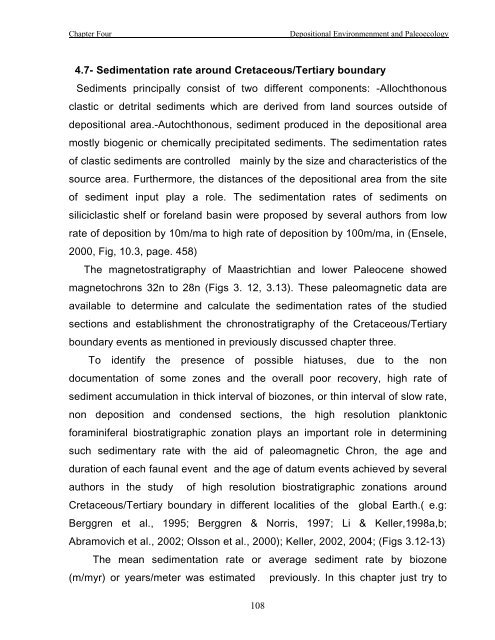biostratigraphy and paleoecology of cretaceous/tertiary boundary in ...
biostratigraphy and paleoecology of cretaceous/tertiary boundary in ...
biostratigraphy and paleoecology of cretaceous/tertiary boundary in ...
Create successful ePaper yourself
Turn your PDF publications into a flip-book with our unique Google optimized e-Paper software.
Chapter Four<br />
Depositional Environmenment <strong>and</strong> Paleoecology<br />
4.7- Sedimentation rate around Cretaceous/Tertiary <strong>boundary</strong><br />
Sediments pr<strong>in</strong>cipally consist <strong>of</strong> two different components: -Allochthonous<br />
clastic or detrital sediments which are derived from l<strong>and</strong> sources outside <strong>of</strong><br />
depositional area.-Autochthonous, sediment produced <strong>in</strong> the depositional area<br />
mostly biogenic or chemically precipitated sediments. The sedimentation rates<br />
<strong>of</strong> clastic sediments are controlled ma<strong>in</strong>ly by the size <strong>and</strong> characteristics <strong>of</strong> the<br />
source area. Furthermore, the distances <strong>of</strong> the depositional area from the site<br />
<strong>of</strong> sediment <strong>in</strong>put play a role. The sedimentation rates <strong>of</strong> sediments on<br />
siliciclastic shelf or forel<strong>and</strong> bas<strong>in</strong> were proposed by several authors from low<br />
rate <strong>of</strong> deposition by 10m/ma to high rate <strong>of</strong> deposition by 100m/ma, <strong>in</strong> (Ensele,<br />
2000, Fig, 10.3, page. 458)<br />
The magnetostratigraphy <strong>of</strong> Maastrichtian <strong>and</strong> lower Paleocene showed<br />
magnetochrons 32n to 28n (Figs 3. 12, 3.13). These paleomagnetic data are<br />
available to determ<strong>in</strong>e <strong>and</strong> calculate the sedimentation rates <strong>of</strong> the studied<br />
sections <strong>and</strong> establishment the chronostratigraphy <strong>of</strong> the Cretaceous/Tertiary<br />
<strong>boundary</strong> events as mentioned <strong>in</strong> previously discussed chapter three.<br />
To identify the presence <strong>of</strong> possible hiatuses, due to the non<br />
documentation <strong>of</strong> some zones <strong>and</strong> the overall poor recovery, high rate <strong>of</strong><br />
sediment accumulation <strong>in</strong> thick <strong>in</strong>terval <strong>of</strong> biozones, or th<strong>in</strong> <strong>in</strong>terval <strong>of</strong> slow rate,<br />
non deposition <strong>and</strong> condensed sections, the high resolution planktonic<br />
foram<strong>in</strong>iferal biostratigraphic zonation plays an important role <strong>in</strong> determ<strong>in</strong><strong>in</strong>g<br />
such sedimentary rate with the aid <strong>of</strong> paleomagnetic Chron, the age <strong>and</strong><br />
duration <strong>of</strong> each faunal event <strong>and</strong> the age <strong>of</strong> datum events achieved by several<br />
authors <strong>in</strong> the study <strong>of</strong> high resolution biostratigraphic zonations around<br />
Cretaceous/Tertiary <strong>boundary</strong> <strong>in</strong> different localities <strong>of</strong> the global Earth.( e.g:<br />
Berggren et al., 1995; Berggren & Norris, 1997; Li & Keller,1998a,b;<br />
Abramovich et al., 2002; Olsson et al., 2000); Keller, 2002, 2004; (Figs 3.12-13)<br />
The mean sedimentation rate or average sediment rate by biozone<br />
(m/myr) or years/meter was estimated previously. In this chapter just try to<br />
108

















